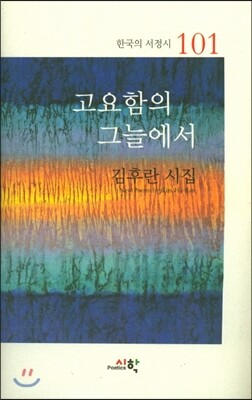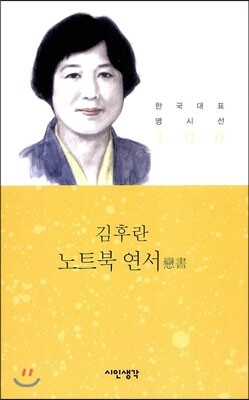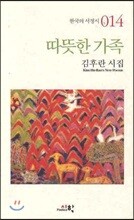Kim Huran (born 1934) is a Korean poet.
Life
Kim Huran was born in Seoul on December 26, 1934. Her professional career has been in journalism; she served as a reporter then as editorial writer for various major newspapers. She left her studies at Seoul National University to work as a reporter for the Hankook Ilbo, the Seoul Shinmun, and the Kyunghyang Shinmun. Her literary career was officially launched when her poems "Oneureul wihan norae" (오늘을 위한 노래 Songs for Today) and "Dalpaengi" (달팽이Snail) were recommended for publication in Hyundae Munhak in 1960. She published her first collection of poetry, Jangdowa jangmi (장도와 장미 Ornamental Knife and Rose) in 1968; this was followed by other volumes, including Eumgye (음계 Musical Scale) in 1971, Eotteon pado (어떤 파도 Certain Waves) in 1976, and Seourui saebyeok (서울의 새벽 Dawn in Seoul) in 1995.
Writing
Kim Huran's poetry is characterized by an intense exploration of symbolist imagery, in an elegant language which at times verges on weightiness. Her work is deeply rooted in the more traditional forms of Korean lyricism. Among the themes most frequently found in her work is a constant celebration of the mystery of vitality. Nature becomes a mirror of the ways in which life succeeds in breaking through the walls of darkness.
One of Kim's's favorite images is the budding and opening of flowers. Life burgeons out of darkness, emerging, developing, growing to perfection. Nature in her work is a place of hope and life, light and beauty. She frequently explores images of water emerging from the depths, brought out from below into the light of day to quench thirst and irrigate dry places.
In her poetry, Kim attempts to create a world of perfect equilibrium and absolute beauty through the practice of self-discipline and control. This great artistic endeavor coincides with the poet's approach towards life seen in "Namueseo" (나무에서On The Tree), in which the poet cultivates mind and soul in order to attain wisdom and maturity. Her poems analyze the conflicts and contradictions of life with a modernist sensibility and capture the beauty and complexities of nature. Her early poems "Ganggae seon namu" (강가에 선 나무Trees on the Riverside), "Badae mearichineun" (바다에 메아리치는 Echoing in the Sea) and "Dabotab apeseo" (다보탑 앞에서 In Front of the Pagoda) aptly portray the many trials and tribulations inherent in life.
En su poesía intenta crear un mundo de perfecto equilibrio y absoluta belleza a través de la autodisciplina y el control. Este gran esfuerzo artístico coincide con la manera que la escritora tiene de acercarse a la vida y que se puede ver en "En el árbol" (Namueseo), en el cual la poetisa cultiva la mente y el alma para conseguir sabiduría y madurez. Sus poemas analizan los conflictos y las contradicciones de la vida con una sensibilidad modernista y capturan la belleza y complejidad de la naturaleza. Sus primeros poemas, "Árboles a la ribera del río" (Ganggae seon namu), "Haciendo eco en el mar" (Badae mearijineun) y Enfrente de la pagoda (Dabotab apeseo) muestran las numerosas pruebas y tribulaciones inherentes a la vida.6
También es conocida por ser una poetisa lírica, en oposición a los llamados poetas "ontológicos".7
Dans ses poèmes, Kim Hu-ran essaye d'atteindre un monde d'un parfait équilibre, et d'une beauté parfaite à travers la discipline et le contrôle de soi. Elle voit ainsi la vie à travers la perspective d'un arbre, arbre depuis lequel elle nourrit sa pensée et son âme pour atteindre la sagesse et la maturité. Ses poèmes analysent par ailleurs les conflits et les contradictions de la vie au quotidien, et captent la beauté et la complexité de la nature. Ses premiers poèmes Arbres au bord de la rivière (Gangga-e seon namudeul), Échos dans la mer (Bada-e me-ari chineun) et Devant la Pagode de Dabo (Dabotap apeseo) sont autant de portraits des tribulations de la vie quotidienne1.
Kim est reconnue comme poète dite « lyrique » par opposition aux poètes dits « ontologiques » en Corée du Sud4.
本名は金炯德で、『韓国日報』‧『ソウル新聞』‧『京郷新聞』の文化部記者、そして『釜山日報』の記者としても勤めた。1960年には『現代文学』に「今日のための歌」が推薦され、本格的な作品活動を始めた。
『靑眉會』の同人として活動しながら、「道端の砂利」、「薔薇」、「ピエロの哀歌」、「あの明かりの下で」などの女性の繊細な感覚と知性が目立つ作品を書いた。「木にて」の詩では、重厚な理知と精神を内面化したものである。
생애
김후란은 1934년 서울에서 태어났다. 본명 김형덕. 서울대 사범대 가정과를 중퇴했다. 고려대학교 국어국문학과 대학원에서 박사학위를 취득했다. 《한국일보》 기자 및 《부산일보》 논설위원 등 언론사에서 오래 일했다.
1959년 시인 신석초의 추천을 받아 《현대문학》에 〈오늘을 위한 노래〉, 〈문〉, 〈달팽이〉 등의 작품을 발표하며 작품 활동을 시작했다. 작가는 여성 특유의 감각으로 일상을 기록한 첫 시집 《장도와 장미》(1968)를 출간하였으며, 이후 《음계》(1971), 《눈의 나라 시민이 되어》(1982), 《너의 빛이 되고 싶다》(2021) 등 활발하게 작품 활동을 하고 있다.
한편 시인은 《서울신문》에서 기자로 일하던 때, 베트남전에 한 달 동안 종군기자로 참여하기도 했다. 이때 경험한 전쟁의 참상으로 인해 인간의 생명이 지니는 의미와 자연에 남다른 관심을 갖게 되었다.
작가는 한국여성개발원장, 한국여성문학인회 회장을 지내며 여성으로서의 목소리를 내왔고, 2001년에 설립된 <문학의집 서울> 이사장을 맡아 문학의 사회적 역할에 기여하고 있다.
작품 세계
김후란은 여성 특유의 섬세한 감각을 토대로 시적인 아름다움의 영역을 확장하고 미적인 것의 의미를 지속적으로 모색하였다. 작가는 인간의 탐욕으로 만들어진 전쟁의 참상을 고발하고 역사가 남긴 상처에 관심을 갖고 작품을 써왔으며, 동시에 자연과 생명, 인간의 육체와 정신의 관계가 지니는 의미를 탐구하고 성찰하는 것을 시적 대상으로 삼아왔다.
첫 시집 《장도와 장미》(1968)는 등단 초기 시인의 섬세한 감각과 세계를 바라보는 유미주의적 태도가 잘 드러난 시집이다.
《음계》(1971)는 감각의 정밀함과 일상적 시어를 통해 삶을 구성하는 자연물을 형상화하고 그 의미를 담아내었다.
《고요함의 그늘에서》(2017)에서 시인은 삶의 진정성, 생명의 의미, 어떻게 살아야하는지 등의 무거운 주제를 작품의 주제로 삼았다. 특히 몸과 정신의 관계에 대한 통찰을 통해 삶의 의미를 확장하려는 시도를 하고 있다.
주요 작품
1) 전집
《김후란 시 전집》, 푸른사상, 2015.
2) 시집
《장도와 장미》, 한림출판사, 1968.
《음계》, 문원사, 1971.
《눈의 나라 시민이 되어》, 서문당, 1982.
《사람 사는 세상에》, 융성출판사, 1985
《오늘을 위한 노래》, 현대문학북스, 1987.
《시인의 가슴에 심은 나무는》, 답게, 2006.
《존재의 빛》, 2012.
《새벽 창을 열다》, 시학, 2012.
《비밀의 숲》, 서정시학, 2014.
《고요함의 그늘에서》, 시학, 2017.
《너의 빛이 되고 싶다》, 답게, 2021.
3) 수필집
《사랑의 파수꾼》, 자유문학사, 1996
《그리움이 사무칠지라도》(공저), 우성출판사, 1989.
《우수의 바람》, 시와시학사, 1994.
《너로 하여 우는 가슴이 있다》, 솔과학, 2003(개정판, 2022).
수상 내역
1968년 제14회 현대문학상
1977년 제3회 월탄문학상
1994년 제31회 대한민국문학상
2000년 제49회 서울특별시문화상
2006년 제22회 펜문학상
2015년 제5회 이설주문학상
2017년 제25회 공초문학상






